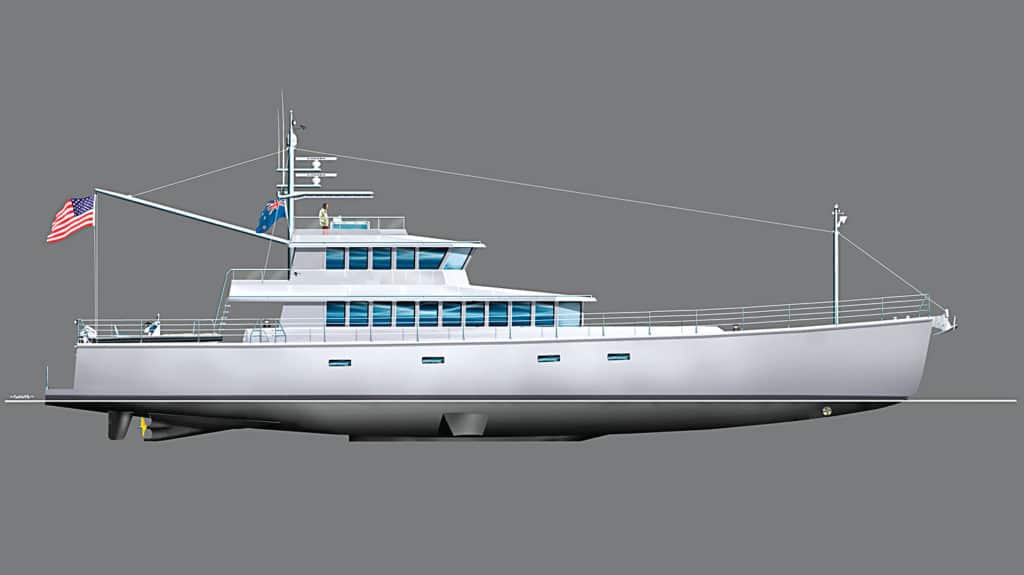
Fast Pilot Boat 115
From a stylist’s point of view, the absence of visual embellishment distinguishes Steve Dashew’s FPB 115 from almost all other long-range vessels. On the outside, she’s pure function, right down to her unfinished aluminum skin. If you find beauty in purpose, you’ll fall for this yacht the way a woodworker falls for his band saw.
When Dashew and his wife, Linda, decided to switch from their 78-foot Sundeer ketch Beowulf to power cruising, he designed the 83-foot _Wind Horse_, the first of his FPB (Fast Pilot Boat) series. This slim, no-frills (on the exterior) long-range cruiser has more than 50,000 miles under her keel, proving the efficacy of this concept.
“The FPB 115 is a natural evolution in the FPB Series,” writes Dashew. “Preliminary numbers indicate better efficiency than her smaller sisters’. She has trans-ocean [sic] range at 12.5 knots/300 nautical miles per day, and given her increased size she will be even more comfortable than the FPB 83.”
Even though the FPB 115 lacks frills, she displays a handful of artful elements. The windows along the sides of the middle deck and the three in the front are pleasingly rectangular and very near the Golden Section ratio of 1:1.618 width to height. All of the panes are vertical, which suits the no-nonsense look of the yacht and makes the most of the volume inside.
In profile, the roof of the middle deck rises from the leading edge to its terminus at the front of the pilothouse, but the plan view reveals a wide, flat section between the tines of this fork. A pair of hatches occupies this flat area, providing light and air to the middle deck. The reverse rake of the windshield reduces glare from outside and cuts down on reflections from lights inside. It also seems to be particularly good at shedding water.
If you slice off the superstructure and focus on the sheer line, the shape of the stem and the hint of a reverse transom, you should see the hull of an attractive sailboat. The shape of the bottom also recalls that of a sailboat, but the way Dashew has distributed the volume below the waterline shows no sign of concessions to balancing the shape for moving at an angle of heel. He drew the forward sections very fine, giving the entry a bit of hollow. The waterlines transition very gradually to maximum beam and, as they approach the stern, tuck in even more gradually to the narrow stern. These sections reduce lift aft and pitching.
“The bow and stern need to be balanced, so that they work together,” Dashew wrote. “A full stern will shove a fine bow down into the oncoming wave, while a full bow will stop the boat cold as the wave impacts it.”
Dashew and his team kept the beam at the waterline quite narrow by modern standards of displacement motoryacht design, relying on length to get the reserve buoyancy the yacht needs. “A very fine bow on a long boat can create as much or more buoyancy as the fat bow of a shorter boat,” Dashew wrote. “The advantage is that you can drive the fine bow through the wave, where the fat bow hits the wave like a breakwater — and stops (or pounds so hard you are forced to slow down because it is too hard on crew and structure). For this to work you need a long waterline and modest beam. When you get it right, the boat will be able to maintain very high rates of comfortable speed into head seas.”
Dashew’s experience and videos confirm his statements, but I’d love to try a passage aboard this FPB 115 to see for myself. I’m sure that when we picked up our mooring in port and took the dinghy to shore, I would look longingly back at her. Function is beautiful.
Dashew Offshore; www.dashewoffshore.com
Plus, read a collection of stories on Dashew’s cruising and designs.









